Learn GIMP: From Greenhorn to Guru in 19 Lessons

fmgbain
GIMP is a very popular graphic program, and though not as popular as Photoshop, there are a good many designers who use it as their first choice.http://www.gimp2tutorials.info/layers.pdfWhile it has some universal features shared by many other graphic programs, as we discussed in the Linux Design Tools: High-end Design on a Low-end Budget? article, it comes with many differences as well.
One of the most notable differences between GIMP and Photoshop is the variations in their GUIs. These differences go beyond pure cosmetics. I know how frustrating it can be when you can’t seem to accomplish a basic task with GIMP, that’s always been a breeze in Photoshop.
That’s why I’ve compiled this list: to get you over that ‘frustration hump’ and into making cool stuff sooner.
While you can’t expect every Photoshop operation to have a GIMP equivalent, almost all the common operations do. The purpose of this article is to not just to help you learn GIMP, but also to show you just what it is capable of producing.
There is certainly no shortage of GIMP tutorials, and even some of the less up-to-date tutorials often still offer value.
The article is divided into sections — from rawest newbie through to more advanced users. Though this is at least partly subjective, it should give you a good progression.
Let’s get started!
Getting Started with GIMP 01 – 101 Tutorial for Beginners: Learning the Basics
This tutorial is one easy tutorial that walks you through the basics of the program. Even if you have absolutely no idea of GIMP and design, you should be able to understand most of it.
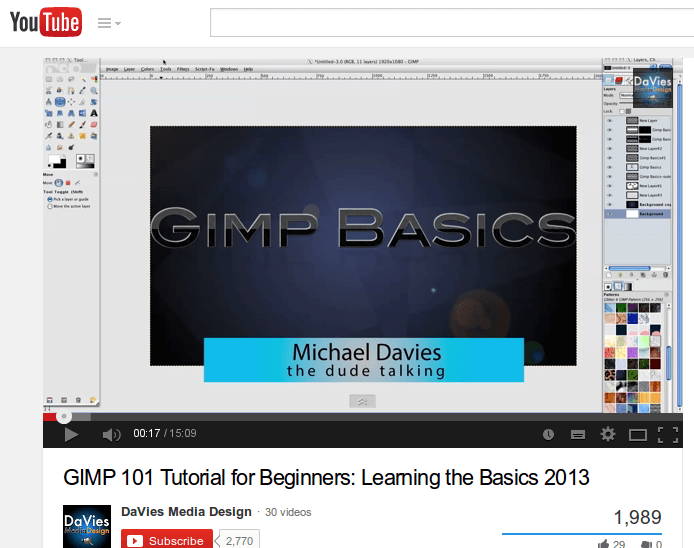
The perfect GIMP starters tutorial
02 – GIMP for Beginners – Lesson 1 – Getting around GIMP
The next general tutorial on the list is ideal for helping you quickly find your way around the GIMP interface. Once more, it’s a video tutorial, and is part of a whole series covering basic GIMP tools, layers, and techniques.
The tutorial itself isn’t very long (about 13 minutes), but if you want to watch all the tutorials in the series, you will need a couple of hours or so.
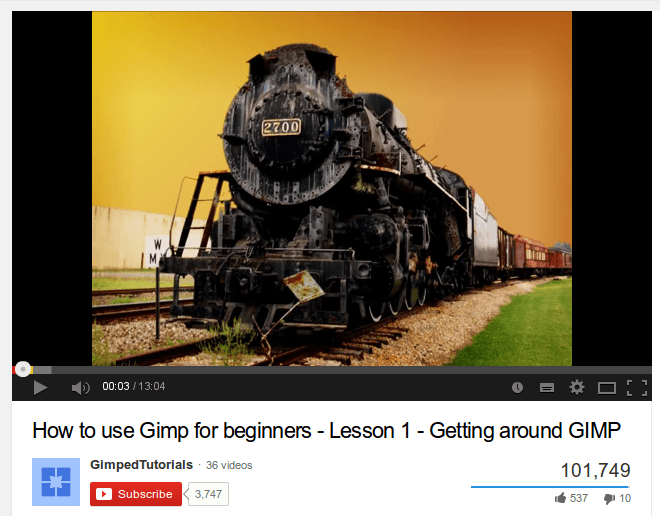

If you prefer reading books to watching video — perhaps you’re a kindle fan — this little ebook about GIMP might be your best choice.
It’s targeted primarily at photographers, but covers the GIMP toolset nicely, so works as an excellent general introduction to GIMP.
Basic GIMP Techniques
Most of the tutorials in the previous section are for beginners, but since they are general tutorials, let’s now move to tutorials for beginners that cover a particular task only.
04 – Mixing Colors in GIMP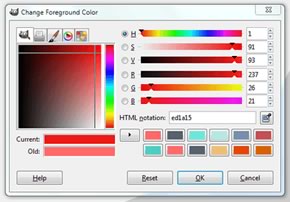
Colors are key to any design and so is the skill how to mix them. If you want to learn how to mix colors in GIMP, check this. You might be thinking that mixing colors is so easy there is no need to have a tutorial about but even experienced users will have what to learn from the tutorial.
05 – Cutting Out An Image Using GIMP
Cutting a small image out of a larger one is a ‘bread-and-butter’ function in any modern graphics editor and GIMP is no exception — this video teaches you the GIMP way to do it.

QuickMask is one of the nice features in GIMP, with a familiar analog in Photoshop. Here is a tutorial to teach you how to use it to achieve a vintage effect.
Of course, you can use QuickMasks for much more than this. This tutorial is an oldie, but GIMP functionality hasn’t changed in this area.

Layers and layer masks are also a core concept in GIMP. Don’t worry, if you haven’t heard of them – this layer masks tutorial explains everything you need to know.
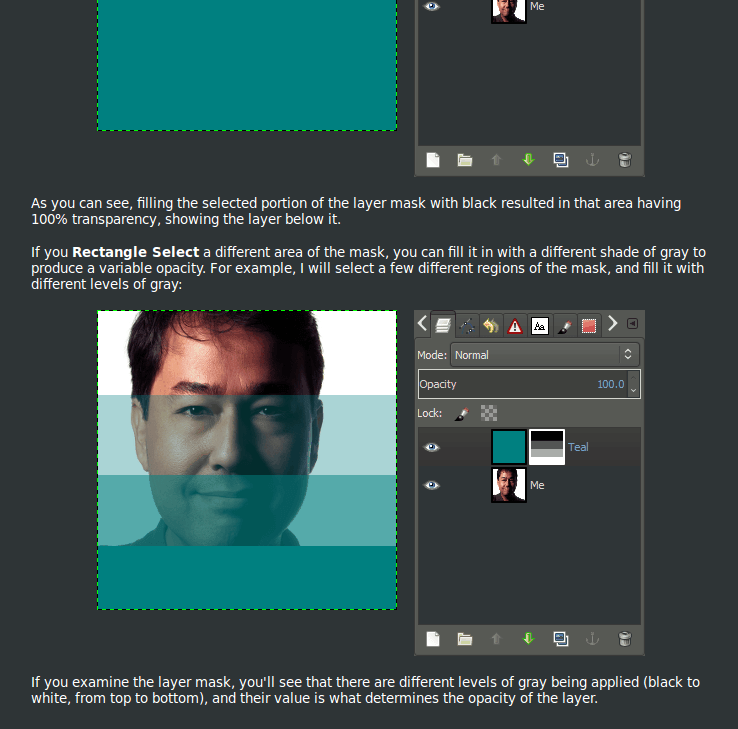

The basic idea of layers is easy to grasp but if you want to go a bit beyond it, this ebook is a great read.
It covers layers, operations with layers, layer masks, etc. Some of the stuff in it is a little advanced, but if you need a solid intro to layers, this one is also OK.
09 – Work With Paths in GIMP
Vectors paths are another key concept in GIMP. Here are two tutorials about paths – one about Bezier selections and one about drawing shapes.
Both tutorials are short and sweet — just a few minutes each to read and try.
10 – Mastering GIMP Filters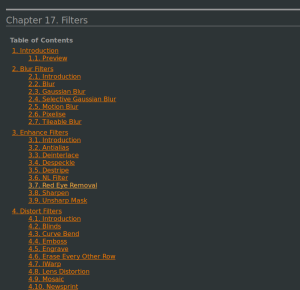
In GIMP filters are an institution. You can do so many things with them!
However, when you are a GIMP newbie, this array of filters might seem hard to conquer. In such cases, a good tutorial about GIMP filters, for instance this one, can help a lot.
To be precise, this tutorial is different from the others – it’s actual GIMP ‘documentation’ but since it is the most comprehensive documentation on filters, it’s a ‘must-read’.
The document lists all filters by group (blur, enhance, distort, light and shadow, noise, edge-detect, artistic, etc.), so no matter which filter you want to look up, it’s there. Obviously, this is no quick read at all – there is so much to read here but you don’t have to read it from start to finish.
11 – Controlling Lighting & Shade in GIMP
Working with shade and lightning is another fundamental skill for designers and photographers. This tutorial provides five ways to use shade and lightning in GIMP.
Tutorials for Advanced Users
This last section contains the most difficult but probably the most interesting stuff – advanced tutorials. I could have included literally dozens of other tutorials, but since many focus on a hyper-specific tasks, we’ve stuck with the more commonly required skills.

This is the third ebook in the series I’ve mentioned in the previous sections. In some ways, this one could go into the ‘Beginners’ section because it covers basic stuff, such as colors and plugins. However, since it also develops into some excellent advanced techniques along the way, I thought it say nicely here.
I suspect even GIMP veterans will have what to learn from this book, so if you have a spare hour, give it a try it.
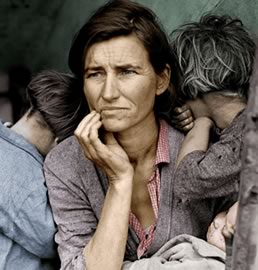
This tutorial colorizes Dorthea Lange’s immortaldepression-era photo.
13 – Colorize a Black and White Photo with GIMP
While most of us won’t need to colorize black and white photos on a daily basis, this tutorial demonstrates a raft of great techniques, including how to use masks, layers, and color tools.
So even if you can’t imagine needing to colorize a picture, you’ll pick up some pretty cool tricks here.
14 – Photo Retouching with GIMP
Photo retouching is another common task for GIMP users. This tutorial covers the whole process in great depth.
Just a short clarification: Not all steps performed on the example image used in this tutorial were done in GIMP – some are performed in another open source graphics program (RawTherapee). However, for many images you won’t need these preliminary steps.

Brushes have been a powerful and versatile component of Photoshop for a long time.
Creating custom brushes in GIMP actually isn’t difficult, but I’ve included it in the ‘advanced tutorials section’ simply because it’s more likely to be required by more advanced users.
Otherwise, the tutorial itself is short and easy.
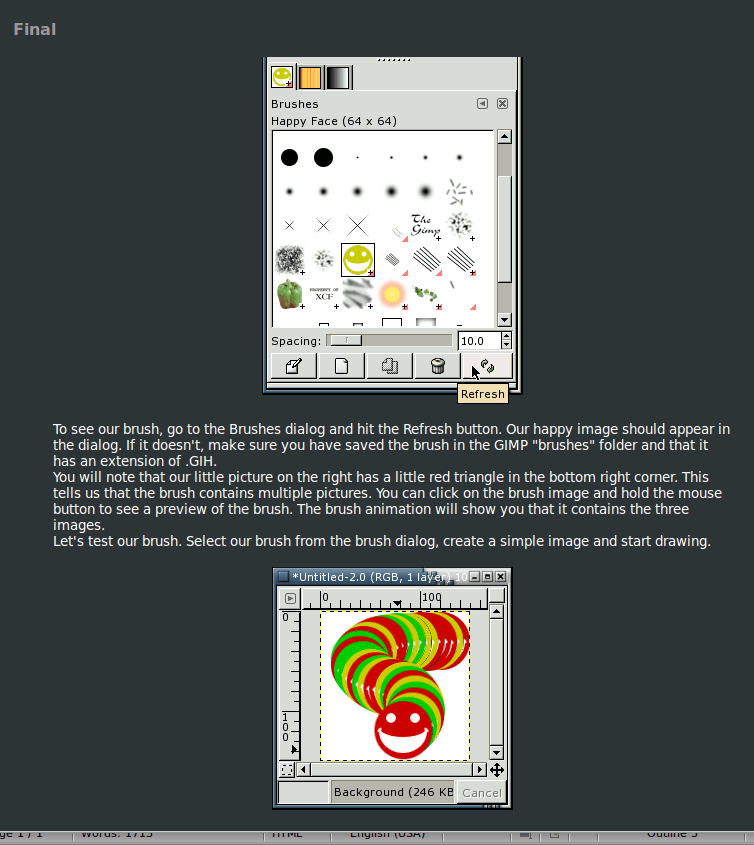
You might be surprised to find out the GIMP is not just for still graphics — it’s great for basic animation as well. While there are certainly other, more specialized open source options for more complex animation, GIMP is great for simple tasks.
You will need the GAP module. After you get that, just follow the steps here and get animating.


Cage Transform is a slick tool to help you correct (or create) perspective distortions. Ian Pullen has put together this thoughtful tutorial to walk you through the basics.
18 – Introduction to GIMP Scripting
GIMP scripting is very powerful, but probably more than just another advanced GIMP topic. In reality, this falls closer to the realm of pure programming than classic visual design. However, I suspect that fact won’t be a negative to many in the SitePoint readership base.
So, if you have some basic programming knowledge — Perl is particularly handy — then rocking some simple GIMP scripting shouldn’t be rocket science for you.
If you are looking for where to start, here is an introduction to GIMP scripting.

GIMP script borrows from Perl.
19 – A Collection of GIMP Text Effects Tutorials
This resource isn’t a tutorial per se, but a site devoted entirely to showcasing GIMP text effects, and how to achieve them. The text effects are organized in different categories – nature, metal, light, ice, glass, fire, 3D, abstract, simple, etc.
I think these tutorials not only teach you GIMP, but also give you a fantastic overview of exactly what it can do.Of course, there are few limits to what you can accomplish with GIMP once you achieve mastery. I hope this list speed you along the journey.
Ada is a fulltime freelancer and Web entrepreneur with more than a decade of IT experience. She enjoys design, writing and likes to keep pace with all the latest and greatest developments in tech. In addition to SitePoint, she also writes for Syntaxxx and some other design, development, and business sites.101 kids’ books about where and how we live
For kids and teens, even more than for adults, books are an opportunity to explore unfamiliar frontiers and learn about other places. So this year, in addition to our list of 101 books about where and how we live geared toward adult readers, we’re recommending titles—spanning picture books, middle grade, and young adult—that are perfect for junior Jane Jacobses and future Frank Lloyd Wrights. And yes, grown-ups are allowed in the kids’ section, too.
Picture books :no_upscale()/cdn.vox-cdn.com/uploads/chorus_asset/file/13250683/101HorizontalRule.jpg)
1. Hello Lighthouse by Sophie Blackall
”Here is a picture book that—warning—may make you want to relocate to a pile of rocks in the middle of the ocean. It won’t be because this Caldecott Award-winning title makes life in a lighthouse look especially easy—it doesn’t—but because you will find such beauty and purpose and love in the lives lived in this cozy home amid crashing waves and changing skies and ships in need of guidance. Steadfastness, service, and family shine in these pages as brightly as a beacon.” —Brian Floca, author and illustrator of Locomotive
2. A Pocket for Corduroy by Don Freeman
”I’ve always loved reading A Pocket for Corduroy by Don Freeman with my son. Even though it’s a sequel and doesn’t have the exact magic of the original, as a “city story” it captures some very specific notes that I’ve never seen anywhere else. In particular, the story takes place in a laundromat where Lisa and her mother take Corduroy along to do their wash. Doing laundry alongside others and their intimates is so… intimate! And so particular to city life. I love this routine part of our experience as the unique set piece for this story.” —Lucy Ruth Cummins, author and illustrator of Stumpkin
3. Subway by Christoph Niemann
Two children and their father spend the day exploring the New York City subway in a story with a fun rhyme scheme. Personified and color-coded subway lines give you a feel for where they will take you.
4. All Aboard! Let’s Ride a Train by Nichole Mara and Andrew Kolb
There are tons of things to find on a train! Readers can fold out this accordion-style book to see what’s on board—like fantastical passengers and their luggage, as well as those who work on trains—while the train travels from a rural setting into a cityscape.
5. Last Stop on Market Street by Matt de la Peña and Christian Robinson
A boy and his grandmother take the bus home through the city. During this trip, the boy asks his grandmother why they don’t have a car or other things people he knows has. She responds with answers that highlight the joy of city life and the things the two of them do have together.
6. Iggy Peck Architect by Andrea Beaty and David Roberts
Iggy has always been an architect and builder who uses whatever materials he can find. But not everyone is won over by his passion. How can he convince his second grade teacher that architecture is a worthy pursuit?
7. Brick: Who Found Herself in Architecture by Joshua David Stein and Julia Rothman
A little brick is inspired to ponder her place in the world by visiting 10 influential brick structures around the world, including a castle, a temple, and an apartment building.
8. Young Frank, Architect by Frank Viva
Young Frank lives with his grandfather, Old Frank. Both are architects, but very different ones. Young Frank likes to build buildings that twist, chairs with zig-zag legs, and even entire cities. But Old Frank thinks architects only build buildings.
9. The World Is Not a Rectangle: A Portrait of Architect Zaha Hadid by Jeanette Winter
Even as a child, Zaha Hadid took inspiration from her home in Baghdad, Iraq, and dreamed of designing buildings and cities. With determination and persistence, Hadid overcame prejudice and setbacks to eventually design a museum, an opera house, a stadium, and even a ski jump, becoming the first woman to earn both the Pritzker Prize and the Royal Gold Medal for her inventive sense of design.
10. Dream Builder: The Story of Architect Philip Freelon by Kelly Starling Lyons and Laura Freeman
This picture-book biography follows the life of architect Philip Freelon, a boy who struggled to read but found passions in math, science, and art—and eventually architecture, specifically by African-American and Islamic designers. After focusing on community spaces like schools, libraries, and museums, he ultimately won the contract to build the Smithsonian National Museum of African American History and Culture.
11. Secret Engineer: How Emily Roebling Built the Brooklyn Bridge by Rachel Dougherty
Women weren’t supposed to be engineers when construction on New York City’s Brooklyn Bridge began in 1883. But Emily Roebling insisted on learning the techniques her husband was using as chief engineer... which came in handy when he fell ill and she secretly took command of this landmark project.
12. A is for Activist by Innosanto Nagara
An alphabetical primer on words associated with fighting for human rights and building and strengthening your community. No one is too young or old to learn words or concepts like “feminist,” “indigenous,” “May Day,” and more.
13. Our House Is on Fire: Greta Thunberg’s Call to Save the Planet by Jeanette Winter
When Greta Thunberg was 15, she learned about climate change from her teacher and was outraged. She began protesting outside of Swedish Parliament on Fridays, with a sign that read “School Strike for Climate,” instead of going to school. A worldwide movement followed, aimed at protecting the environment.
14. Good Morning, Neighbor by Davide Cali and Maria Dek
A mouse leaves one morning in search of an egg to make an omelet, but soon he also has apples, flour, and sugar for a cake—and a community to share it with.
15. Hey, Wall by Susan Verde and John Parra
In a community full of a life, a boy ponders how he can fix up a bleak-looking building wall to reflect the life he knows. In this story of urban renewal, he and his neighbors come together to create a beautiful mural and build a stronger connection.
16. A World of Cities by James Brown
Explore the world with exquisite travel poster-style images, filled with facts about cities like Seoul, New York, and Istanbul.
17. This Is How We Do It by Matt Lamothe
All over the world, kids wake up, go to school, and play. While the traditions and methods of living day to day may differ, the similar rhythm is universal. This book offers day-in-the-life glimpses of the lives of seven children around the world.
18. How a House Is Built by Gail Gibbons
How a House is Built is an accessible, step-by-step introduction to designing, constructing, and moving into a house. Kids will learn about the processes and the people involved, like carpenters, plumbers, and landscapers.
19. How Cities Work by Lonely Planet Kids
A fun lift-the-flap book where readers can peel away the layers of a city to see how its subway systems, sewers, and more work—and find some quirky items hidden in the illustrations along the way!
20. Here We Are: Notes for Living on Planet Earth by Oliver Jeffers
Beautifully illustrated in Oliver Jeffers’s classic style, Here We Are: Notes for Living on Planet Earth is a gentle and witty how-to guide for Earth, with advice about navigating its terrain and being good to all creatures that live on it.
21. We Came to America by Faith Ringgold
Told in verse, We Came to America is an inclusive look at the people who make up America, from the indigenous people who were already on the land to those forced to come here in chains to those who immigrated by choice or who came here for safety.
22. The Journey by Francesca Sanna
A deeply affecting story of a refugee family escaping war and traveling by any means they could to a country that does not welcome them with open arms.
23. If You Lived Here: Houses of the World by Giles Laroche
Why might a house be built on stilts (Chile) or in a tree (USA) or be able to be carried on its resident’s back (Mongolia)? If You Lived Here: Houses of the World introduces young readers to different types of housing around the world and how they came to be.
24. Good Morning, City by Pat Kiernan and Pascal Campion
By TV anchorman Pat Kiernan, Good Morning City welcomes the day by celebrating those already at work before your little one is even out of bed—like the baker, the ferry boat captain, and the TV anchorman. As the sun begins to rise, so does the city, until everyone is out and has started their day.
25. Home by Carson Ellis
A lovely look at the different types of structures—as real as apartments or as fanciful as shoes—that can become a home.
26. Small in the City by Sydney Smith
When everything is so big around you, being small in the city can be very scary. But it helps to have useful tips on how to navigate the bustle, and if it becomes too much, there’s always home to welcome you back to its calm safety.
27. Herman & Rosie by Gus Gordon
Herman and Rosie live in two very small apartments in a very busy city on a very busy street. Both love the rhythm of the city, a rhythm they also tap into by playing the oboe (Herman) and listening to jazz records (Rosie). But sometimes being among such bustling crowds can make you feel lonely, until one night Herman and Rosie happen to meet through their love of music and play together on a New York rooftop.
28. Winter in the City by Sue Tarsky and Claire Lordon
A walk through a city in the winter can double as practice for counting and identifying the colors of cars and other things you may find.
29. This Is Our House by Hyewon Yum
Follow a family through generations of living in the same house, from immigrating to raising families to making it a true home for them all.
30. Richard Scarry’s Busy, Busy Town by Richard Scarry
”I don’t think any books have explained the places I’ve lived better than Richard Scarry’s vibrant, idealized cities. What’s even more amazing is how the colorfully illustrated and helpfully labeled details have been updated over the years to reflect our ever-changing communities.” —Alissa Walker, urbanism editor, Curbed
31. Goodnight, Goodnight, Construction Site by Sherri Duskey Rinker and Tom Lichtenheld
It’s time for bed, and all the hard-working trucks need to go to sleep. As they do, kids are introduced to trucks like Crane Truck, Cement Mixer, Dump Truck, Bulldozer, and Excavator and learn what basic function each one serves on a construction project.
32. This is New York by Miroslav Šašek
The classic picture book on New York City, exploring the buildings, the sites, and the personality that make NYC worthy of its Big Apple moniker.
33. The Street Beneath My Feet by Charlotte Guillain and Yuval Zommer
This oversized, double-sided foldout book is a fun introduction to earth science. By peeling away the layers of the earth down to its core, readers begin with topsoil and insects and move down deeper and deeper to the subway system and artifacts from lost generations.
34. Sky Dancers by Connie Ann Kirk and Christy Hale
Set in the early 1930s and based on the history of Mohawk steelworkers, Sky Dancers follows a boy who goes into New York City to see his dad work on the steel beams of the Empire State Building.
35. Crown: An Ode to the Fresh Cut by Derrick Barnes and Gordon C. James
An ode to community fostered by local barbershop culture and the feeling that a young boy has when in the barber’s chair, surrounded by adult role models. He feels a burst of self-confidence re-entering the world with a fresh cut—ready to be whoever he wants to be.
36. 101 Small Ways to Change the World by Lonely Planet Kids and Aubre Andrus
There are many ways to make the world better, whether it’s talking to a new friend, taking a shorter shower to save water, or spending more time with family. 101 Small Ways to Change the World is divided into sections like Ideas for Caring for Others, Ideas for Caring for the Planet, and Ideas for Caring for Yourself.
Middle Grade :no_upscale()/cdn.vox-cdn.com/uploads/chorus_asset/file/13250683/101HorizontalRule.jpg)
37. The Great Jeff by Tony Abbott
”In a body of stellar work, The Great Jeff may well be Abbott’s finest work. It is a nuanced depiction of the rapid and all-too-common decline of an average family into homelessness. And ultimately, it is a profoundly moving story of friendship, disappointment, growing up, enormous courage, and empathy.” —Nora Raleigh Baskin, author of Nine, Ten: A September 11 Story
38. Liar & Spy by Rebecca Stead
“In Rebecca Stead’s Liar & Spy, Georges moves into a Brooklyn apartment and forges a friendship with a boy who convinces Georges they need to spy on one of their neighbors. As truths are revealed, the story and relationships underscore the tension between the alienation and intimacy of living in a city apartment building.” —Dorian Cirrone, author of The First Last Day
39. How to Steal a Dog by Barbara O’Connor
”Georgina, her mother, and her baby brother have been forced out of their apartment, thanks to the departure of her profligate father. But they can’t find another place that is cheap enough to afford on just her mom’s income. So, they take up residence in their car. This is a book that shines a light on both the trials of poverty as well as the inner strength it takes to find a solution.” —Kathi Appelt, author of The Underneath
40. The Remarkable Journey of Coyote Sunrise by Dan Gemeinhart
”Place is identity in Dan Gemeinhart’s The Remarkable Journey of Coyote Sunrise. A bus becomes a home and provides a sanctuary for a grieving father and daughter. The passing landscape drives the plot as much as the characters as they run away from a past that feels too tragic to overcome.” —Jamie Sumner, author of Roll With It
41. It’s Your World: Get Informed, Get Inspired & Get Going by Chelsea Clinton
Chelsea Clinton presents issues like poverty, climate change, health, and gender equality, with ideas for how kids and teens can have an impact on solving them.
42. The Kid’s Guide to Service Projects: Over 500 Service Ideas for Young People Who Want to Make a Difference by Barbara A. Lewis
For kids who are looking to create change in their communities, The Kid’s Guide to Service Projects includes a “10 Steps to Successful Service Projects” advice list as well as ideas for service projects small and large, from volunteering to contacting your local government about changes you’d like to see in your community.
43. Refugee by Alan Gratz
Following three child refugees from three different time periods—Josef is a Jewish boy living in 1930s Nazi Germany, Isabel is a Cuban girl in 1994, and Mahmoud is a Syrian boy in 2015—Refugee illuminates the similarities in many refugees’ stories of seeking safety.
44. The Arrival by Shaun Tan
A wordless graphic novel that beautifully depicts the experience an immigrant has upon arriving in a new urban environment without understanding the language or knowing anyone.
45. Inside Out and Back Again by Thanhha Lai
Inspired by the author’s experience as a refugee, Inside Out and Back Again is the story, told in verse, of a girl who escapes the fall of Saigon with her family and faces the uncertainty of a new life in America.
46. Other Words for Home by Jasmine Warga
When life in her hometown in Syria becomes volatile, Jude and her mother are sent to Cincinnati to live with relatives, leaving her older brother and father behind. Told in verse, Other Words for Home is a lyrical and hopeful story of life’s unexpected surprises, even when you feel like home is far away.
47. The Boy at the Back of the Class by Onjali Q. Raúf
When an empty chair at the back of the class is filled one day by a Syrian refugee, his classmates learn he escaped a Very Real War and decide to band together to help reunite him with loved ones. A child-friendly introduction to the refugee crisis and the power of community.
48. Where the Heart Is by Jo Knowles
It’s the beginning of summer and Rachel just turned 13, and she’s facing greater challenges than ever before. Her new job tending to the neighbor’s farm isn’t going so well, her best friend’s feelings for her leave her questioning her sexuality, and her parents have been fighting more often about finances—they may even lose their home.
49. The House that Lou Built by Mae Respicio
Lou longs to have a place of her own, apart from the bedroom that she shares with her mom at her grandmother’s house, which always seems to be filled with her large Filipino family. So she decides to DIY a 100-square-foot “tiny house” that she can have all to herself.
50. The Stars Beneath Our Feet by David Barclay Moore
Living in Harlem isn’t always easy for 12-year-old Lolly, but building a fantastical city of Legos is sure helping. Even though it won’t bring back his older brother, who died from a gang-related shooting a few months ago, maybe it can help build a bridge back to the world.
51. Dear Sweet Pea by Julie Murphy
When Sweet Pea’s parents get a divorce, her dad moves into a nearly identical house two doors down to “help” with the transition. But dividing her time between houses isn’t easy, and it doesn’t help that at school, Sweet Pea has to sit next to her former best friend, a daily reminder of another loss.
52. Chasing Redbird by Sharon Creech
When Zinny discovers the old, overgrown path through the woods behind her family’s house, she knows that her summer is going to change. Finding out where it goes and clearing the way, she has the chance to carve out a place of her own—and uncover the answers to all kinds of questions.
53. One Crazy Summer by Rita Williams-Garcia
Three young girls from Brooklyn visit their estranged mother, who’s found a radical new life in Oakland with the civil rights movement. On their own to make the best of their summer—despite having to attend a Black Panther-sponsored day camp—they sightsee through San Francisco, discovering new realities they couldn’t have imagined.
54. The Breadwinner by Deborah Ellis
Living in a bombed-out apartment building in Kabul, Afghanistan’s capital city, during Taliban rule, 11-year-old Parvana’s father loses his job and health when the school he teaches in is bombed. To make money, he begins to read letters for the illiterate on a carpet in the marketplace. But when he’s arrested for having a foreign education, Paravan decides she must transform into a boy to help her family survive.
55. A Place to Belong by Cynthia Kadohata
World War II has ended, but 12-year-old Hanako can no longer call America home after her country imprisoned her and her family in internment camps and then sent them to live in Japan, a country she’s never known. As she struggles to adapt to life in the small village, she learns that broken places can become stronger when they’re put back together.
56. Brown Girl Dreaming by Jacqueline Woodson
Written in accessible poetry, Brown Girl Dreaming is an autobiographical story about feeling halfway at home in both North Carolina and New York, experiencing the lingering effects of Jim Crow, Woodson’s growing awareness of the civil rights movement, and how she found her place in the world through writing stories, despite having difficulty reading.
57. Take Shelter: At Home Around the World by Nikki Tate and Dani Tate-Stratton
For anyone interested in different types of homes around the world, Take Shelter is about how a floor, a roof, some windows and doors are the basic components of a home, and how they can be drastically different in different places. Some are permanent, some are temporary, but all are constructed to provide shelter in the environment they’ve been constructed for—from the Arctic to the Antarctic, from an underground house in Las Vegas to the International Space Station.
58. Far From Fair by Elana K. Arnold
When Odette’s family packs her and her annoying younger brother into an RV and drives away from California, she finds living in a cramped space with only one cellphone to share completely unfair. And that’s before they arrive at her grandmother’s house to discover an even greater unfairness for the family.
59. The Paris Project by Donna Gephart
If only Cleveland could get out of her unsophisticated small town in Florida and to the American School in Paris, everything would be better. It wouldn’t matter as much that she’s ashamed of her father, or that she barely sees her mother and sister, who have to work extra shifts to make ends meet. While working hard to check off items on her Paris Project List, she learns to accept the people in her life for who they are and to bloom where she’s planted, even if it isn’t Paris.
60. Look Both Ways by Jason Reynolds
Told in 10 tales—one per city block—after school dismissal, Look Both Ways interweaves points of view into a satisfying novel about the reasons we do things and the detours we take on our way home.
61. The Vanderbeekers of 141st Street by Karina Yan Glaser
The large biracial Vanderbeeker family might lose its beloved brownstone after the landlord refuses to renew the lease. The five siblings decide to try to win the house back with an all-out charm offensive—because they can’t afford to lose their home.
62. New Kid by Jerry Craft
Seventh-grader Jordan Banks would prefer art school over the prestigious private school his parents decide to send him to, far away from his Washington Heights neighborhood and culture—Jordan is the only person of color in his class. New Kid’s graphic-novel format works honestly to depict the visual differences between the neighborhood and class worlds of New York City.
63. Better Nate Than Ever by Tim Federle
Stuck in a small, close-minded town in Pennsylvania, Nate dreams of becoming a Broadway star in New York City—and successfully runs away to audition for E.T.: The Musical. While wandering around Times Square, then downtown, then all the way to Astoria, Nate realizes that the city’s true magic is offering people the ability to find (and be!) themselves.
64. Honeybees and Frenemies by Kristi Wientge
Every summer, Flor’s small town of Honeydale has its annual Honey Festival pageant for second graders. But this year, there’s a reunion pageant planned, and Flor is paired up with her frenemy and former best friend to jointly compete in what ruined their friendship. And it might be the last summer Flor spends with the familiar characters she’s learned to love in Ohio—if her parents can’t make their mattress store profitable, she and her family will have to move across the country.
65. When You Reach Me by Rebecca Stead
The Upper West Side, Miranda’s New York City neighborhood, is practically a character in When You Reach Me, a mystery set in 1979. Anyone who grew up in a city will recognize many aspects of Miranda’s upbringing, and for those who didn’t, the novel is a window onto city-kid life.
66. The Story of Buildings: From the Pyramids to the Sydney Opera House and Beyond by Patrick Dillon and Stephen Biesty
An illustrated narrative history of construction, this book features 16 structures, from the Egyptian pyramid of Djoser (Step Pyramid) to the Renaissance to modern skyscrapers. The creators, style, and historical significance of the designs and buildings are all covered.
67. Built to Last by David Macaulay
Combining and updating three previous books, Built to Last explains the construction process and history of structures that have endured—including castles, cathedrals, and mosques from around the world—with the incredible illustrations that David Macaulay has become known for.
68. Curious Constructions by Michael Hearst and Matt Johnstone
Covering 50 man-made structures, including the Eiffel Tower and Stonehenge, Curious Constructions explains with great wit how constructions, either useful or unnecessary, came to be.
69. The Future Architect’s Handbook by Barbara Beck
For children with architectural ambitions, The Future Architect’s Handbook takes young designers through the steps of making plans for and building a house.
70. Who Built That? Modern Houses: An Introduction to Modern Houses and Their Architects by Didier Cornille
A biographical look at 10 famous houses of the 20th and 21st century, with accessible and graphic illustrations of both the creators and the homes during their construction.
Young Adult :no_upscale()/cdn.vox-cdn.com/uploads/chorus_asset/file/13250683/101HorizontalRule.jpg)
71. My Sister Rosa by Justine Larbalestier
“I inhaled this chilling, gripping novel about a teen boy, Che, who suspects his younger sister might be a psychopath. Che has recently moved to New York’s East Village with his family, and as his dread around his sister’s behavior grows, he finds solace in the warmth, energy, and generosity of his new neighborhood. It’s a love letter to the city and a reminder that one need not look further than the local bodega, boxing gym, or community garden to restore one’s faith in the goodness of humanity.” —Kass Morgan, New York Times best-selling author of the 100 series and Supernova
72. American Street by Ibi Zoboi
”Ibi Zoboi’s fantastic book American Street shows with incredible detail and clarity the culture shock of leaving one’s home behind while being flung into a new city and way of life. It’s a heart-wrenching story that’s intricately woven through the streets of Detroit.” —Whitney Gardner, author of Chaotic Good
73. The Hate U Give by Angie Thomas
Sixteen-year-old Starr is trying to fit into both her low-income community and her privileged private school when she becomes the center of a national publicity battle as the only witness in a police shooting of an unarmed friend.
74. The Education of Margot Sanchez by Lilliam Rivera
Margot is doomed to spend the summer working at her family’s grocery store to pay off the debts she accrued using the family credit card to keep up appearances at her posh private school. Despite all this, she’s determined to win an invitation to the ultimate beach party—and will in no way be distracted by Moises, the neighborhood boy who’s spending all his time advocating against gentrification in the Bronx.
75. Dear Martin by Nic Stone
Despite leaving behind a rough area of Atlanta, Justyce still feels like the reputation of his old community haunts him—especially when a police officer handcuffs him when he was only trying to help out a friend. Justyce looks to the words of Martin Luther King Jr. for guidance.
76. Girls Resist!: A Guide to Activism, Leadership, and Starting a Revolution by KaeLyn Rich and Giulia Sagramola
Learn how to go from being angry about the state of the world to doing something about it. This guide to beginning a movement will help you organize protests and stand up for change in your community.
77. We Are Here to Stay: Voices of Undocumented Young Adults by Susan Kuklin
Read the stories of nine undocumented teens who came to the U.S. from Colombia, Mexico, Ghana, Independent Samoa, and Korea to escape war or poverty or to seek education. These heartbreaking and hopeful stories counteract sweeping generalizations about immigrants in America.
78. I Am Not Your Perfect Mexican Daughter by Erika L. Sánchez
A tragic accident in downtown Chicago leaves Julia an only child, facing all the pressures of being exactly who her Mexican parents want her to be. But Julia isn’t her sister, and she isn’t ready to play that role—even if her sister may not have been as perfect as everyone thought.
79. Americanized: Rebel Without a Green Card by Sara Saedi
At 13 years old, Sara Saedi found out a secret about her family: They came to the U.S. from the Middle East as undocumented immigrants. Her true story is equally moving and funny, as her concerns over being deported nearly equal her worries about being the only person without a date to the prom.
80. This Side of Home by Renée Watson
Portland, Oregon, is gentrifying and Maya doesn’t recognize her neighborhood anymore—or her sister, who is happy to hang out at all the trendy new coffee shops. As she feels her community and her black identity slipping away, she begins to wonder if growing up means growing apart from those closest to her.
81. The Fortress of Solitude by Jonathan Lethem
This is the story of a teen’s 1970s Brooklyn neighborhood, which is almost entirely black despite the first whispers of something that will become known as “gentrification.”
82. No Place by Todd Strasser
Dan, the star of his baseball team, goes from middle class to homeless when his father loses his job. When they move to a tent city, Dan slowly realizes he can’t relate to his friends the way he used to, and that only worsens when he gets involved with the fight to better the conditions of those living in tent city.
83. Here in Harlem by Walter Dean Myers
A collection of poetry by beloved author Walter Dean Myers from 54 different points of view, all those of people who live in and make up Harlem: the mail carrier, the jazz artist, the basketball player, the teacher, and more.
84. Nick and Norah’s Infinite Playlist by David Levithan and Rachel Cohn
A love letter to New York City as well as an all-night romp, Nick and Norah’s Infinite Playlist begins with a desperate Nick asking Norah to be his girlfriend for a few minutes, but they end up spending the night searching the city for a legendary band’s secret show and changing each other’s lives forever.
85. American Girls by Alison Umminger
A teen runs away from home to join her estranged sister, who lives in LA and works on movie sets, and discovers the not-so-glamorous side of the city. Through a research project on the Manson girls, she finds her own similarities with lost American girls from the past.
86. In Search of Us by Ava Dellaira
A multigenerational story of a mother’s and daughter’s parallel lives. A teen road-trips to LA in search of information about her father and his family, who she’s never known, while the reader learns the story of her mother and her own search for love as an LA teenager.
87. A Tree Grows in Brooklyn by Betty Smith
The classic and beloved story of an impoverished adolescent girl living in Williamsburg, Brooklyn, during the turn of the century, and the aspirations that define her. A far cry from the hip and established neighborhood it is today, Betty Smith’s poignantly illustrated Williamsburg is from a time when families lived in tenements and children sold junk for pennies.
88. She’s the Worst by Lauren Spieller
In a tribute to LA, two sisters revive a pact to relive their greatest hits in a scavenger hunt across the city, with one trying to cheer up the other, who’s decided to stay home for college. But not all is what it seems, and a secret is revealed that may rip their family apart.
89. More Happy Than Not by Adam Silvera
It’s been difficult for 16-year-old Aaron Soto to be happy since his dad killed himself a few months ago. He finds solace in Thomas, despite his Bronx crew thinking they’re spending too much alone time together. When Aaron’s feelings become too much, he considers turning to a revolutionary new memory-alteration procedure to straighten himself out, even if it means forgetting who he truly is. Taking place primarily in the Bronx, this book is a critical love story about the borough the author grew up in.
90. Permanent Record by Mary H.K. Choi
When one of the world’s biggest pop stars meets a guy working at a Brooklyn bodega at 5 a.m., their interaction feels like it has potential for more. The bodega and its owners give this book a neighborhood feel.
91. York by Laura Ruby
Fifty-seven years after the Morningstar twins envisioned a New York City with never-before-seen technological advances, they went missing, leaving behind a cipher they built into the city. Now, in an alternate NYC that exists parallel to the present-day city, three teens must save their historic apartment building by proving the cipher is real.
92. Sky Without Stars by Jessica Brody and Joanne Rendell
Set in an alternate, futuristic version of Paris on another planet (complete with its own rendition of the Eiffel Tower), Sky Without Stars is the first in a science-fiction series based on Les Miserables. The extravagant elite class reigns supreme on the planet of Laterre, but there are whispers of revolution—and it hinges on three unlikely heroes.
93. The Last Boy and Girl in the World by Siobhan Vivian
A storm has destroyed Keeley’s hometown and she has to pack up and leave before it’s completely underwater, but there’s still a little time to have fun first—like taking one last shot at the guy she’s always loved.
94. The Sun Is Also a Star by Nicola Yoon
The Sun Is Also a Star follows the unlikely meeting and love story between a Jamaican American who’s set to be deported that day and a Korean American who is set to have an interview with a Yale alum to please his parents. The reader sees their respective days unfold and intertwine in New York City.
95. City of Bones by Cassandra Clare
When 15-year-old Clary heads to a club in New York City, she doesn’t expect to witness a murder, to see the body disappear into thin air, or to discover that Shadowhunters exist to rid the world of demons. This gritty urban fantasy takes iconic New York City locations and turns them into paranormal hot spots for its epic characters and world of the Shadowhunters.
96. The Serpent King by Jeff Zentner
As three misfit friends begin their last year of high school in a small, do-nothing town in Tennessee, they grapple with what to make of their future: whether they’ll be able to escape to New York City or even Nashville, or if they’ll be stuck where they are forever.
97. Archidoodle: The Architect’s Activity Book by Steve Bowkett
Learn by completing architectural activities—like designing a skyscraper, an island house, or a Constructivist monument—alongside examples of work and ideas from major architects.
98. The Guerilla Art Kit by Keri Smith
Leave your mark out in the world and art out on the street. With step-by-step exercises and project ideas for stickers, chalk drawings, and more, you’ll learn how to use your artistic talent to create a message that could brighten someone’s day or make someone think.
99. Cool Architecture by Simon Armstrong
Packed with absorbing facts and quirky illustrations, Cool Architecture tells you everything you need to know about architecture around the world, from the simple dwellings created by the earliest humans to today’s most innovative buildings.
100. Women of Steel and Stone: 22 Inspirational Architects, Engineers, and Landscape Designers by Anna M. Lewis
Offering historical context (suffrage, civil rights, the Industrial Revolution, and more), these profiles of women architects, engineers, and designers offer a well-rounded look at who they were and the cultural moments they often bumped up against.
101. Draw Buildings and Cities in 15 Minutes by Matthew Brehm
Learn how to draw buildings and cities when and where you see them. Draw Buildings and Cities in 15 Minutes teaches you the ins and outs of drawing in public and explains how to keep a personal record of the buildings and sites that most interest you.
Disclosure: Elizabeth Kossnar edited Honeybees and Frenemies, one of the titles included on this list, but receives no direct financial benefit from sales.
Jupiter images thrill, inspire public to participate
Processing images from the camera aboard NASA's Juno spacecraft orbiting Jupiter has turned into a cottage industry of sorts, as rank amateurs, accomplished artists and experienced researchers turn relatively drab "raw" images into shots ranging from whimsical to spectacular and everything in between.
The question is, how accurately do they reflect reality, and is there any way for the casual observer to judge the result?
Unlike other NASA spacecraft, the JunoCam imager aboard the Juno spacecraft was added to the mission primarily for public outreach. Its pictures have no bearing on the mission's scientific objectives, which rely on a suite of eight other instruments to study Jupiter's interior structure, its gravity and magnetic fields and its immediate environment.
JunoCam's images are only lightly processed by the camera's builder -- Malin Space Science Systems of San Diego -- and immediately posted on line. What happens after that is up to the public.
"Once it's in their hands, we have no control, nor do we want to exert any, over what they do with the data," said Candy Hansen, a senior scientist at the Planetary Science Institute and the JunoCam instrument lead. "So we have gotten everything from careful scientific-type processing to incredibly whimsical works of art. So it's a little bit, for you, a buyer-beware situation."
 A storm on Jupiter, as processed by Gerald Eichstadt and Damian Peach, compared to a raw image from NASA's Juno orbiter (inset lower right. NASA/JPL/SwRI/MSSS/Gerald Eichstadt/Damian Peach
A storm on Jupiter, as processed by Gerald Eichstadt and Damian Peach, compared to a raw image from NASA's Juno orbiter (inset lower right. NASA/JPL/SwRI/MSSS/Gerald Eichstadt/Damian Peach
Even so, she said, "we're all in, in the sense that I don't have a team of scientists and image processors waiting in the wings in case the public doesn't show up. We don't have a budget, we don't have staff or anything like that. So we are entirely, 100 percent, relying on the public. And some of them have done fabulous work."
Juno is the first spacecraft to be sent into an orbit around Jupiter's poles, and JunoCam was designed primarily to capture detailed images of the planet's heretofore unseen polar regions.
Because of weight, volume and power restrictions, the spacecraft could not support an advanced telescopic camera. Instead, it was equipped with a relatively simple imager with what amounts to a fish-eye lens. Malin Space Science Systems provided a similar camera to photograph the Curiosity rover's descent to Mars.
While JunoCam is not as powerful as the sophisticated telescopes and sensors launched aboard other NASA probes, Juno's elliptical orbit carries it closer to Jupiter than any other spacecraft, within a few thousand miles of the giant planet's cloud tops. As a result, it's wide-angle views provide exceptional detail and more context than high-power narrow-angle instruments.
But how realistic are the public's interpretations of JunoCam images? With other NASA spacecraft, the viewer can have confidence the photos were processed and reviewed by scientifically competent team members and that the images reflect some sort of scientific reality.
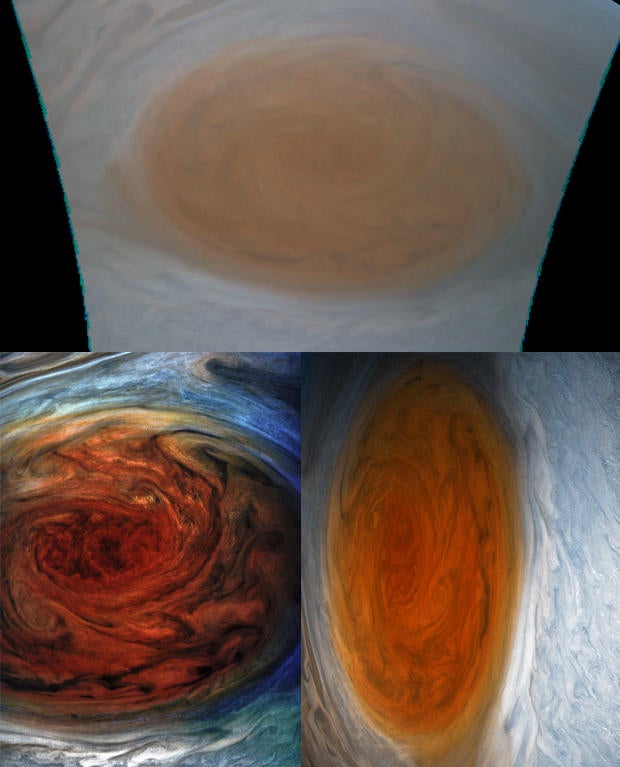 A raw JunoCam image of Jupiter's Great Red Spot, top, compared to processed images that bring out detail difficult to make out in the original. NASA/SwRI/MSSS/Gerald Eichstädt/Séan Doran
A raw JunoCam image of Jupiter's Great Red Spot, top, compared to processed images that bring out detail difficult to make out in the original. NASA/SwRI/MSSS/Gerald Eichstädt/Séan Doran
With public processing, as Hansen said, it's more a case of buyer beware, and the relatively bland raw images lend themselves to Photoshop-type manipulation. To Hansen, the line between a scientifically accurate image and one that takes liberties with the data is "the minute you depart from true color."
"The minute you start making the blue a little bluer and the red a little redder, now you've enhanced the color. And when you really go to the sort of wild ends of the color palette, then I would call it exaggerated. If you're just plain making up things, then it's false color."
So should viewers wanting to learn more about Jupiter prefer realistic lighting and color to enhanced or exaggerated images?
"Let me argue against that," she said. "Our human eye-brain combination is better at seeing details that are there when you exaggerate it a bit, when you enhance it a bit. The details, you can see (them) if you know what you're looking for in the true color images. But it's so subtle, it's really, like, washed out. I would say we learn a lot by looking at enhanced color images because it pops more to the eye-brain combo."
Raw images from JunoCam are posted on a website Hansen helps manage. Each raw image includes the same view shot in green, blue and red filters and then a slightly processed color view that is a combination of all three. The public can download those images, process them in a wide variety of ways and upload the results back to the website.
As long as the processed images relate to Jupiter, and don't contain unrelated or objectionable material, they are re-posted and available for anyone to download. All are in the public domain, although uploaders can opt to restrict commercial usage.
Hansen cited several processors for their work, including Björn Jónsson, who she said goes to great lengths to ensure realistic lighting and color, and Seán Doran, a graphic artist whose enhanced images are "incredibly beautiful, they are drop-dead gorgeous."
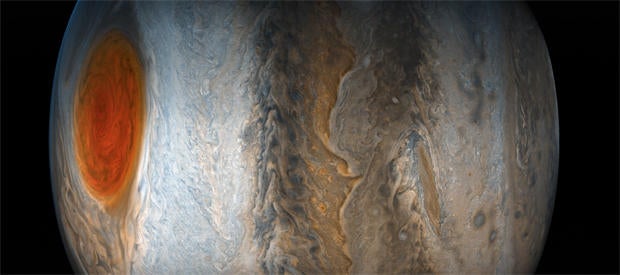 A view across Jupiter showing its Great Red Spot and multiple atmospheric bands as visualized by artist Séan Doran. NASA/SwRI/MSSS/Gerald Eichstädt/Séan Doran
A view across Jupiter showing its Great Red Spot and multiple atmospheric bands as visualized by artist Séan Doran. NASA/SwRI/MSSS/Gerald Eichstädt/Séan Doran
Gerald Eichstädt, a mathematician and software developer, devised code to ensure uniform lighting across an image, Hansen said, adding "I'm urging him to write up an actual science paper and get some credit for all that work, at least in the scientific community."
In an email exchange with CBS News, Doran said his images are based on Eichstädt's work, adding "my aim is to provide an aesthetic enhancement to what he has done."
"I use a range of techniques in Photoshop to extract detail and enhance subtleties in the source image," he wrote. "This can develop into quite a large set of actions and layers each with different non-destructive adjustments and masks. These layers are treated with various blend modes to provide finer control in mixing toward the final image.
"I also use exposure settings to draw the eye and give volume to the image. Knowing when to stop is intuitive, and in some cases I will scrap what I have done and start again."
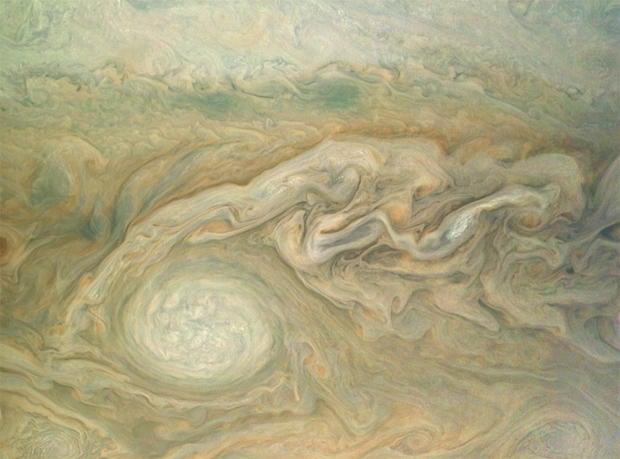 Björn Jónsson's processing of JunoCam imagery shows how Jupiter's cloud tops might be seen by the human eye, with realistic colors. NASA/JPL-Caltech/SwRI/MSSS/Björn Jónsson
Björn Jónsson's processing of JunoCam imagery shows how Jupiter's cloud tops might be seen by the human eye, with realistic colors. NASA/JPL-Caltech/SwRI/MSSS/Björn Jónsson
He said he was "inspired" by the work of Jónsson and Justin Cowart, "whose images provide realistic renderings of Jupiter. Their work is beautiful."
Last Monday, Juno flew over Jupiter's Great Red Spot for the first time, a highly anticipated event. The Great Red Spot is the largest, most powerful storm in the solar system, stretching more than 10,000 miles across. Within minutes of the first raw images being posted, image processors around the world began uploading their interpretations.
"People must have been just sitting there waiting with Photoshop open!" Hansen laughed. "Within 45 minutes, I already had a queue to approve. This has really been fun."
Said Doran: "We are only at the start of coming to grips with this data, and in time I expect to see very many beautiful and harmonious treatments."
 Stunning views of Jupiter 29 photos
Stunning views of Jupiter 29 photos
Comments
Post a Comment